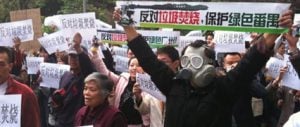Xie Yong could be called a pioneer. He is one of very few to date to sue a Chinese government agency over its unlawful refusal of requested data. His crusade for change has little to do with civic altruism, however. Xie’s struggle is personal in nature, his actions forced by desperation. He has been battling his son’s paralysis-causing epileptic seizures and mounting health care costs since 2010. His son’s condition, Xie believes, is the result of toxic emissions from an incineration plant near his home.
Xie and his wife, Ma Hongmei, lived in Nantong, Jiangsu province, when Ma gave birth to their son, Yongkang, in 2008. Even before they could celebrate his first 100 days of life, Yongkang’s parents noticed he was not developing normally. He did not laugh like other babies and had trouble seeing and hearing. Most disturbing, he twitched incessantly and could not be placated. Shortly after, he became paralysed. Doctors eventually diagnosed him with cerebral palsy.
During Ma’s pregnancy and in her son’s first two months of life, the family lived a short distance from the local trash incineration plant. The facility’s odorous emissions were constant, but neither Ma nor Xie understood what risks they might be facing. Shanghai Xinhua Hospital determined that Yongkang’s disease was not genetic, but caused by environmental factors during Ma’s pregancy.
Xie researched the science behind incineration emissions and health defects, spoke with experts, and learned that other couples in the village had experienced premature births and stillbirths. The couple concluded that their proximity to the plant, and the constant pollution it spewed, were to blame.
In 2010, Xie sought the assistance of the Center for Legal Assistance to Pollution Victims (CLAPV), a China-based legal aid NGO that provides assistance to citizens and wages legal battles in the name of environmental justice. The centre felt that his story justified legal action and, with Xie’s help, began collecting the evidence needed to build a case against the company that owned the plant, Jiangsu Tianying Saite Environmental Protection Energy Group.
In China’s first personal health-related legal case against a waste incinerator, the Hai’an local court heard the case in September 2010. Xie submitted analysis revealing dioxin concentrations in nearby air that grossly exceeded legal limits; reports documenting the physical condition of plant workers and other children living near the plant; and scientific papers demonstrating a link between dioxin and birth defects. The local judge rejected Xie’s claims, prompting him to appeal to the county court. A county-level trial took place May 2011, with similar results. The court deemed the evidence insufficient and issued a verdict against Xie.
In response to these blows, Xie turned directly to the authorities. He filed a request for emissions data for the plant in question from the local environmental protection bureau, to which he had legal entitlement (read more about China’s open government information laws here and here). His request was denied, on the grounds that releasing data would compromise the company’s business secrets. Xie next asked the provincial level Ministry of Environmental Protection, one administrative level higher, to release emissions reports to him. They, too, turned him down. But he is determined to continue his fight.
Activists like CLAPV’s Liu Jinmei believe that Xie’s efforts “indicate a growing awareness of safeguarding the rights of victims of pollutants”. However, it is hard to know how many individuals with situations similar to Xie’s, but completely unaware of the potentially serious health risks they face, are out there. This is because conditions at Chinese waste-to-energy facilities are by and large shrouded in mystery.
The incineration boom
China did not commission its first waste-to-energy plant until little more than a decade ago. Before 1990, public waste-treatment infrastructure handled less than 2% of the country’s household waste. At the same time, output of inorganic rubbish was marginal.
Rapid change in waste production and management trends occurred in China over the last two decades. China now generates over a quarter of the world’s garbage, at least 250 million tonnes annually. With municipal solid waste (MSW) growing 8% to10% annually, cities are under great pressure to deliver advanced waste-management solutions.
Landfills currently handle roughly half of China’s MSW, while only about 10% is incinerated. Official credo suggests that landfills will continue to play a dominant role. But Beijing’s push to increase the share of burned waste is unmistakable: a central target calls for 30% of MSW to be treated by waste-to-energy incineration by 2030.
Presently, incineration is growing at a feverish pace. Industry insiders and state-run media routinely declare 300 plants will be operational by the time the 12th Five-Year Plan runs its course in 2015. A 2009 study by banking group Standard Chartered found that over one-half of global orders for new waste-incineration facilities came from China.
Information on the number of waste-to-energy plants in China is scarce and, when available, difficult to unpack. Interviews with experts and policymakers rarely converge on a single number, but their guesses routinely fall somewhere between 100 and 200. In an independent, verified assessment I conducted in 2011, I detected at least 155 plants currently operating or under construction. I would not be surprised if plans for new plants have been announced in the three months during which my data has aged.
China’s earliest incineration plants deployed imported grate burn technology common in developed economies. Plant operators quickly found that Chinese MSW generally makes poor feedstock. This is because China’s vast informal sector extracts the most easily burned trash, like paper, wood and plastic. The remaining composition is largely organic waste, too wet to burn without costly pre-treatment or fuel supplements. Technological barriers aside, the price of these technologies also puts them out of reach for China’s second and third-tier cities.
Combined with these practical obstacles, Beijing’s drive to localise environmental technologies helped catalyse (state-funded) development of domestic incineration technologies suited to Chinese conditions. Newer plants prominently feature domestically developed equipment, including both grate and circular fluidised-bed (CFB) type incinerators. Though smaller in terms of capacity, CFB incinerators generate similar amounts of electricity to stoke grates. They are also more flexible in terms of feedstock, permitting coal to be added for easier ignition. For these reasons, CFB incinerators enjoy considerable popularity in the market and now account for about half of China’s MSW treatment capacity.
Early central-level legislation on municipal waste management – passed almost a decade ago – sanctioned private-sector involvement. These measures, intended to encourage growth in waste-to-energy installations, relaxed state control in a way that has yet to take place in the energy sector. However, the primary catalyst for growth in the sector has been generous government incentives.
Waste-to-energy incineration is classified as a renewable energy form in China, meaning that plants receive a feed-in tariff for every kilowatt hour of electricity they generate. Only two months ago, Beijing announced a fixed subsidised price for power purchased from waste-to-energy plants, which is about double that from coal-powered plants.
The results of these subsidies are dramatic. Both foreign and local waste-to-energy players have rushed to stake their claims, in some cases submitting loss-making tender offers just to get a foothold. Many waste-management experts suspect that Chinese city officials are among the most eager investors; using public infrastructure and tax revenue to profit personally.
Peeling back a green facade
The ongoing justification for favourable waste-to-energy policies in China is simple: cities stem the problem of growing waste while getting much needed electricity in the process. That formula, however appealing, appears too good to be true.
China’s incinerators, though canonised as a “clean energy,” have a dirty underside. Thermal waste treatment plants are subject to emissions regulations considerably looser than those for power plants. Legally, they can emit nitrous oxide and sulphur dioxide at, respectively, four and five times the levels of power plants in China.
Newer facilities are installed with air-pollution control systems, but these are costly to use and maintain. Thus, many plants operate without the required flue gas filtering equipment. Likewise, treatment of other highly toxic byproducts – such as wastewater removed before incineration and fly ash created during burning – tends to be either poor or non-existent. This follows partly from the lack of regulations on how waste-to-energy plants should treat wastewater.
The company which operates the facility near where Xie Yong’s family lived boasts on its website that it uses an advanced pollution control system which meets European emissions standards, but no details are given. This is a common claim among waste-to-energy developers. On the other hand, air and water pollution in waste-to-energy plants in China has been well-documented. According to some reports, some plants emit dioxins at levels 24 times higher than those from American waste-to-energy facilities.
Making matters worse, plant operators regularly add coal to the burning waste. In private interviews, Waste-to-energy plant operators admitted to using a feedstock mix comprising equal parts coal and rubbish, which far exceeds the 20% coal limit mandated by the central government. It is not unheard of for the share of coal to be as high as 70%. Under these conditions, plants are operating essentially as small coal-fired power stations – exactly the kind of facility that Beijing is trying to eliminate on public health grounds.
Finally, while incineration plants in Europe charge rubbish haulers “tipping fees” that may reach US$132 (840 yuan) per tonne of waste, these fees rarely exceed US$16 (100 yuan) per tonne in China, and usually hover around US$8 (50 yuan). When Xie’s son was born, the plant near his house was making US$10 (64 yuan) for each tonne of trash they accepted. Many experts say that environmentally sound performance, and the costs it requires, is not technologically feasible with such low tipping fees.
Light beyond the haze
Weak regulation and misaligned policies, combined with an absence of public emissions data, make for a truly toxic incineration sector. Xie Yong is not the only one who has noticed.
Beginning a few years ago, communities near existing plants, offended by odorous emissions and worried about possible health risks, began protesting against new projects. In one incident, which took place in Xie’s Jiangsu province, as many as 10,000 residents gathered and clashed with police over a waste incinerator in their village. According to Chinese media reports, by mid-2010 construction of at least six new plants had been postponed due to public opposition.
By some accounts, China’s leadership has heeded the warnings. In interviews, city officials have said that some Chinese mayors are blocking new projects, concerned they could trigger unrest, thereby marring their reputations and chances of promotion.
Alongside these grassroots efforts, NGOs like Beijing-based Green Beagle are working to substantiate public opposition to incineration with actual emissions performance data. Having campaigned for, and been denied, credible figures for almost five years, the organisation is exploring the possibility of establishing independent waste-to-energy emissions monitoring stations.
As for Xie Yong, it is too early to say whether he can navigate a way through China’s legal system and extract the data he is so desperate to get his hands on, in the belief it will demonstrate a more direct relationship between the plant’s operations and his son’s crippling illness. With every other option exhausted, Xie decided early this year to sue the provincial-level Ministry of Environmental Protection at the Jiangsu provincial court. The trial is expected to take place later this year.
“Taking the ministry to court is my last choice,” Xie has said. “It’s the only way I can get justice.” Though his case is still unresolved, growing numbers of onlookers await the outcome.
Xie’s legal fight – the first of its kind – highlights the pressing need for greater transparency and accountability in the incineration sector. At the same time, growing popular opposition suggests that persistent, and public, resistance may be China’s best bet for achieving meaningful regulatory reform in the waste-to-energy sector.
Elizabeth Balkan is principal at Emergence Advisors.
Homepage image by Greenpeace


